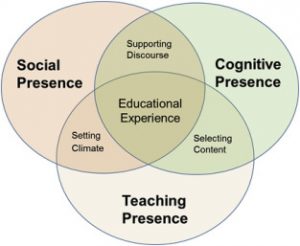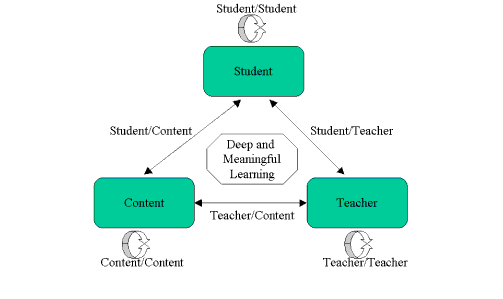3. The role of presence in online teaching
“Social presence is important, get it going right from the start, it helps with interaction, make sure the students think of you as a person” (Online Educator, Farrell et. al, 2019)
In this chapter we consider the role of presence in teaching online. Both educators and students can feel isolated when teaching and learning online. Establishing a sense of a learning community is important to help overcome this sense of isolation, and enables meaningful and in-depth interactions where learning experiences can be shared. In order to build a learning community, it is important that both educators and students establish a social presence in the online course. Presence is generally considered to be the ability of the individual to project themselves as a ‘real person’ in the online environment. The idea of online educator and student presence was discussed extensively within the Community of Inquiry (CoI) model, as put forward by Garrison, Anderson and Archer (1999). Students are more likely to be satisfied with their online courses when they get to ‘know’ their educator, and are more likely to engage in online interactions when their educator is regularly present in the course (Abdous, 2011; Dunlap & Lowenthal, 2018). In the context of online education, presence promotes student to student and student to educator relationships that, hitherto, required physical classrooms.
What does the literature say?
While research into specific roles for online educators began with Berge (1995), the work of Garrison, Anderson and Archer (1999) sparked discussion on the idea of online educator presence. Within the CoI Model it is considered that learning occurs within the intersection of cognitive, social and teaching presence (Garrison et al. 1999).

The community of inquiry model
Teaching Presence refers to the design and provision of cognitive and social activities that support students in achieving the desired learning outcomes.
Cognitive Presence is established when participants in a community of inquiry successfully construct meaning through continued communication.
Social presence is generally considered to be the ability of the individual to project themselves as a ‘real person’ in the online environment.
Educational experience occurs at the intersection of the three presences; cognitive, social and teaching in the CoI model. In other words, all three presences are thought to be required for successful learning to occur.
History of the CoI Framework
In an interview for the Reflective Teaching in a Digital Age podcast, Dr. Randy Garrison describes the history of the CoI framework, including its role in the thoughtful design of online education, and practical ways of helping students learn through active participation and shared meaning making.
Click here to listen to the interview on the history of CoI
Social presence, which focuses on the building of student and teacher relationships, has been found to be an important aspect of online teaching. When online educators model and promote good social presence this has a positive impact on student engagement in the online course (Corfman & Beck, 2019). Getting social presence right from the beginning of the online course is important. Feng et al (2017) found that effective scaffolds for social presence at the beginning of the course ensured students social presence was maintained throughout the course (Feng et al., 2017). In the next section, we will consider how to apply the theories of presence in a practical manner when teaching online.
Interaction and presence in online courses
Related to the community of inquiry model is the concept of interaction in online courses. The concept and theory of interaction was first proposed by Moore (1989) in his article about “Three Types of Interaction” in distance education. Moore thought that interaction in distance education courses followed three distinct patterns: student–content, student–teacher, and student–student. Andersen (2003) extended and applied Moore’s model to the online context in his Modes of Interaction (2003) theory, see diagram below:

Terumi Miyazoe has written a very nice blog post about this topic: Getting the Mix Right Once Again: A Peek into the Interaction Equivalency Theorem and Interaction Design
Andersen argues that deep learning is facilitated as long as long of the three forms of interaction. Therefore when designing an online course, you must consider the modes of interaction and approaches to promoting presence and community in the course.

Feedback/Errata